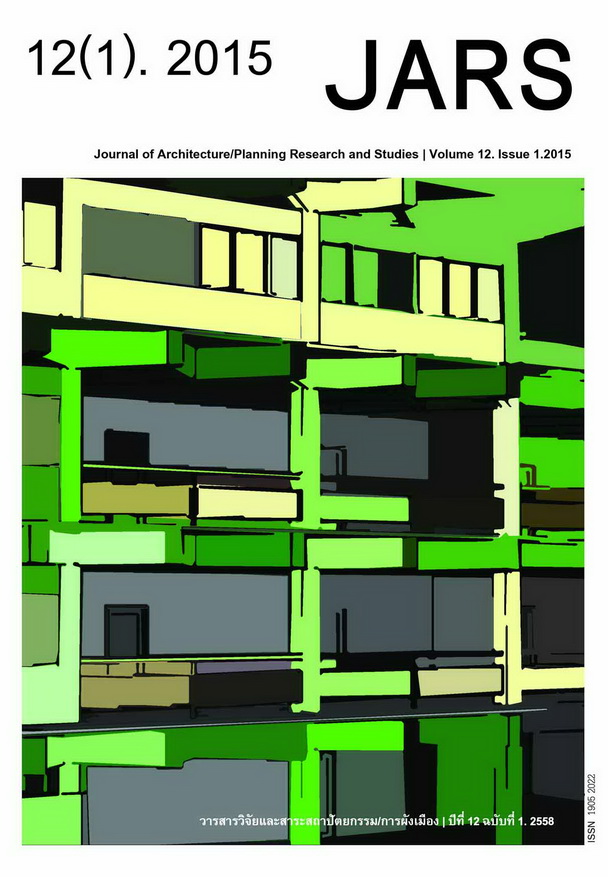Public Real Estate Performance Measurement: A case studyof a Bangkok Government Complex
Main Article Content
Abstract
Various studies have shown that corporate real estate can contribute to organisational performance. However, the concept of Public Real Estate Management (PREM) has not been well known in Thailand. This paper aims to present the concept of PREM, to describe Key Performance Indicators (KPIs) that are being used in practice, to discuss KPIs that should be developed furthermore, and to explore which organisational characteristics affect the selection and prioritisation of KPIs. The empirical study is based on data from a case study of Dhanarak Asset Development Company Limited (DAD). Research methods include interviews, walk-through observations and document analysis. The findings from the case study confirm the assumed relationships between performance measurement and organisational characteristics such as organisational objectives, structure and management style. Although the DAD organisation applies a systematic performance measurement approach, it is recommended to elaborate some KPIs furthermore such as employee satisfaction with the work environment and the rate of customer retention. The findings from the case study can be used to improve the current knowledge of the impact of public real estate management on organisational perfor-mance, and to develop a holistic performance measurement system for public real estate in Thailand.
Downloads
Article Details

This work is licensed under a Creative Commons Attribution-NonCommercial-NoDerivatives 4.0 International License.
All material is licensed under the terms of the Creative Commons Attribution 4.0 International (CC-BY-NC-ND 4.0) License, unless otherwise stated. As such, authors are free to share, copy, and redistribute the material in any medium or format. The authors must give appropriate credit, provide a link to the license, and indicate if changes were made. The authors may do so in any reasonable manner, but not in any way that suggests the licensor endorses you or your use. The authors may not use the material for commercial purposes. If the authors remix, transform, or build upon the material, they may not distribute the modified material, unless permission is obtained from JARS. Final, accepted versions of the paper may be posted on third party repositories, provided appropriate acknowledgement to the original source is clearly noted.
References
Amaratunga, D. & Baldry, D. (2002). Moving from performance measurement to performance management. Facilities, 20(5/6), 217-223.
Carlopio, J. R. & Gardner, D. (1992). Direct and interactive effects of the physical work environment on attitudes. Environment and behavior, 24(5), 579-601.
Carpenter, R. (2014). How to calculate customer retention. Retrieved from http://www.evergage.com/blog/how-calculate-customer-retention
Dhanarak Asset Development [DAD]. (2009). The assessment of organisation’s performance in 2009. Thailand: Author.
Kaganova, O. & Undeland, C. (2006). Implementing municipal asset management reform in countries with emerging markets: lessons learned. In O. Kaganova & J. Mckellar (Eds.), Managing government property assets: international experiences (pp. 297-316). Washington D.C., USA: The Urban Institute Press.
Kaplan, R. S. & Norton, D. P. (1992). The balanced scorecard – measures that drive performance. Harvard Business Review, 70(1), 71-79.
Lebas, M. J. (1995). Performance measurement and performance management. International Journal ofProduction Economics, 41(1/3), 23-35.
McMillan, S. (2006). Added Value of Good Design. Building Research and Information, 34(3), 257-271.
Neely, A., Gregory, M. & Platts, K. (1995). Performance measurement system design: A literature review and research agenda. International Journal of Operations & Production Management, 15(4), 80-116.
Riratanaphong, C. (2014). Performance measurement of workplace change in two different cultural contexts. PhD. Thesis. Delft: Delft University of Technology.
Simons, R. A. (1992). Public real estate management – Adapting corporate practice to the public sector: The experience in Cleveland, Ohio. The Journal of Real Estate Research, 8(4), 639-654.
Sinclair, D. & Zairi, M. (1995). Effective process management through performance management. Business Process Reengineering & Management Journal, 1(1), 75-88.
Tatom, J. (1991). Public capital and private sector performance. Federal Reserve Bank of St. Louis Review, 73(3), 3-15.
Thirakomen, K. (2009). New Bangkok government mega center: a turning point of green modern office. EEC Engineering network: Bangkok, Thailand.
Van der Schaaf, P. (2002). Public real estate: Challenges for governments. Delft: DUP Science.
Zairi, M. (1994). Benchmarking: The best tool for measuring competitiveness. Benchmarking for Quality Management & Technology, 1(1), 11-24.


